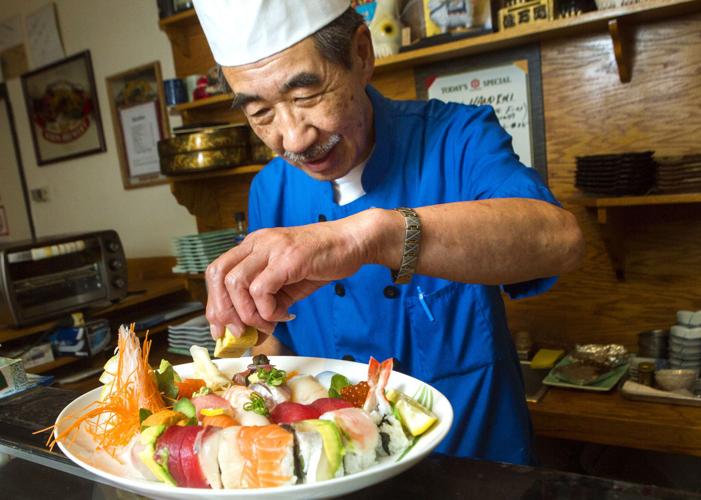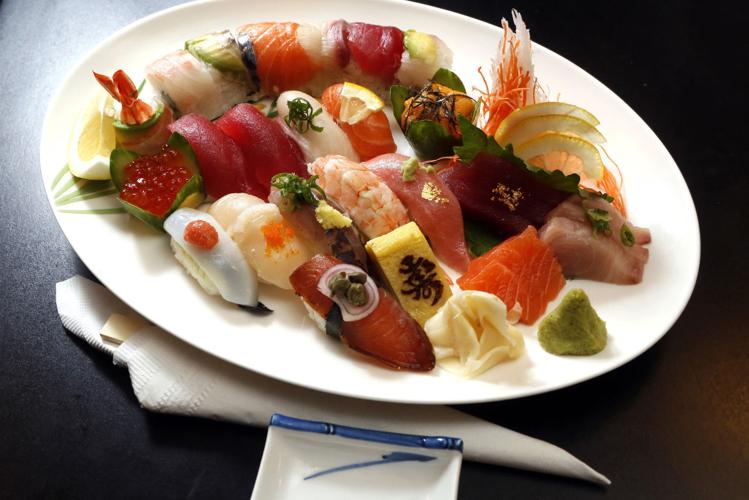I do not want to write this review.
Not because Yamato Japanese Restaurant isn’t good.
But because it is so good.
If it gets crowded, snagging a table for a quiet meal of fish so fresh that its fins practically flap might prove difficult.
This small nondescript restaurant easily gets lost in a strip mall at East Grant Road and North First Avenue.
Ambiance is nonexistent (though we love the clock behind the sushi bar — with nigiri marking where the hours should be, and the damp, hot towels presented before the meal starts).
But really, who needs ambiance with fish this good?
Noboru Nakajima is the owner/chef behind the sushi bar. He’s been cooking more than 40 years, and has been at this spot for 27.
He’s friendly, though don’t try to engage him when it’s busy — he’s got fish to cut, plates to arrange, food to serve.
Otherwise, he laughs easily and is willing to answer questions. Though, truth be told, he can be maddening with some of his answers: “Where is this fish from?” “The sea,” he says with a grin.
Nakajima came to Tucson from Japan a little more than three decades ago, bringing the cooking and sushi skills he learned in his home country.
We sat at the sushi bar at one of our two visits and indulged primarily in the nigiri — raw fish on a finger of sushi rice. Sandwiched between the two is wasabi — just as much as the chef thinks is needed and no more. When the fish is this fresh, you really don’t want it any other way. There are two nigiri to an order. That makes sharing easy, though one taste and we don’t think you’ll want to do that. The other thing: With just two pieces, you’ll want more. And then more. That can get pricey.
Our impressions:
Amaebi
($7.50)
If you are going to have raw shrimp, this is the kind to have. They are big and beautiful — the pink body sits on the rice, and the red tail sort of fans out over the edge. They look almost exotic. The shrimp is soothingly sweet — cook it and you’ll lose that sweetness. It has a clean, almost pure aftertaste. They are plump babies, which is fine by us — the more of it, the better.
Nakajima asked if we wanted the heads. He would eat the head, he said with confidence. We would, too, then. It came fried in a delicate tempura — light and crispy. OK, the brain was a touch bitter but hey, why wouldn’t it be? We just ate the poor thing.
Hamachi
($5.25)
The yellowtail is a fleshy fish, a tad oily, and packed with a buttery flavor. It’s quite luxurious going down. Yamato’s hamachi is generous and delectable.
Scallop
($5.25)
We have to admit to being new to raw scallops. And we cannot believe we have wasted so much time not eating them. Fat, creamy, a touch briny and incredibly sweet, the scallop slithering down the throat is a delight. Don’t drown this one in soy sauce, but do try it with a bit of wasabi — the heat and sweet love each other.
Striped bass
($4.25)
The bass is mild, with kind of flaky but firm flesh. The meat is moist. The taste is not terribly distinctive, slightly sweet. At Yamato, the just-caught flavor made it a fish that you’ll want to go back to.
Tai
($5.25)
Most of us know this as red snapper. One of the ways you can gauge the freshness of this fish is by the flesh — softer means it’s been aged, firmer is an indication of a fresher fish. That doesn’t mean aged snapper isn’t good — it is. The flavor is more robust. We had the fresher version at Yamato, and the delicate taste suited us just fine.
Anago
($5.50)
Who knew sea eel could be so shockingly good? It is velvety soft, enticingly sweet. Some hold that anago is an aphrodisiac. It’s easy to see that — the taste and texture are very sensual.
Quail egg shooter
($4.50)
We had seen Nakajima prepare this for another customer — tiny quail eggs in a sauce — and then saw the customer knock it back with glee. We had to know why. “It’s hot today,” Nakajima warned when it was ordered. The sauce is a combo of soy and fish sauces, a touch of citrus, and hot sauce. The delicate quail eggs are dropped raw into the sauce and delivered without the yolks broken. Those eggs are mild and silky. You can let them slip down with the spicy sauce, but bite into those yolks and the richness of the eggs becomes even more prominent. We were a bit squeamish about the taste and texture of raw eggs, but Nakajima converted us. Though he was right — that sauce was spicy enough to cause the eyes to water and clear the sinuses.
Otoro
($18)
This one isn’t listed on the menu, but Nakajima offers it and it is a bite of heaven. OK, the cost is out there for two pieces of fish. But it is so much more than that. Otoro is the most delectable part of the tuna — the underbelly of the blue fin. A delicate pink color, it almost evaporates in the mouth it is so tender. Tuna is a fatty fish, and you can see the marbling on the oily flesh. Nakajima tops it with gold flakes. It’s a huge indulgence. That price reflects that otoro is the most prized chunk of meat of the tuna. And then there is this: the demand for blue fin has increased around the world, and that has led to overfishing. That impacts the price. And our conscience, as well.
Other than fish …
On a return visit, we knew we had to expand our horizons. The teriyaki chicken ($14.50) off the regular menu had a pretty amazing sauce — teriyaki sauce can be too sweet, too thick. At Yamato, it is neither of those things. Unfortunately, it topped an overcooked chicken breast. The ramen ($10.50) was fine, though the broth wasn’t particularly distinctive — it cried out for a bit more ginger, at least. The chicken broth had slices of pork floating in it, a hard-boiled egg, and twisty noodles that were not noteworthy at all.
At Yamato’s it’s the fish you want. And you’ll want it again and again.






